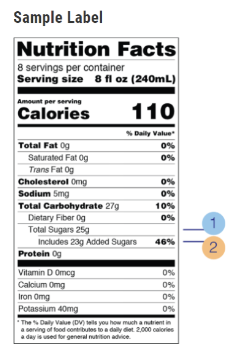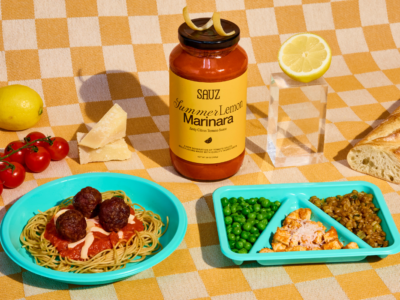With the array of sugars and sweeteners on the market today, it’s easy to get confused, so I’m here to break down the four different types of sugars and how to recognize them.
1. Total Sugars
- When you are looking at a Nutrition Facts label on a package of food, there is a category called Total Sugars with an amount listed next to it (see label below – line circled as #1).
- “Total Sugars” include sugars naturally found in nutritious foods and beverages, such as sugar in cow’s milk and fruits, as well as any added sugars that may be present in the product1.
- There is no Daily Value for Total Sugars because no recommendation has been made for the total amount to eat in a day2.
- For example, for 8 medium strawberries the Total Sugars are approximately 8 grams, but there are 0 grams of Added Sugars (more on added sugars soon3).

Source: FDA 2022
2. Added Sugars
- In the Nutrition Facts label above, you can see a line for Added Sugars (line circled as #2). This form of sugar is added into certain foods or drinks.
- Added sugars, such as table sugar, offer no health benefits and can be detrimental to health. They are often referred to as “empty calories.”
- Studies have found a strong positive association between the consumption of added sugars and the risk of developing obesity and type 2 diabetes4.
- The US Dietary Guidelines recommend that children under 2 years old avoid foods and beverages with added sugar and that children 2-18 years old keep added sugar to less than 10% of calories per day.This video shows how I think you can apply this recommendation to real parenting life.
3. Natural Sugars
- The sugar in fruit is called Fructose. Unlike Added Sugars, the sugar in fruit is combined with fiber, vitamins and other minerals that promote good health5.
- Fructose from natural foods can be healthy as part of a balanced diet. Processed fructose – like high fructose corn syrup – should be limited.
- The sugar in cow’s milk is called Lactose. These are natural sugars and the main carbohydrate in milk. This is different from flavored cow’s milk, which contains lactose, but also added sugars.
4. Non-Nutritive Sweeteners (NNS)
- Six NNS are approved for use by The Food and Drug Administration (FDA), including aspartame, acesulfame-potassium, neotame, saccharin, sucralose, and advantame.
- Currently, the Nutrition Facts label does not have a line item for these sweeteners. They would be listed as an ingredient, but the amount of each in the product is not required to be listed (yet!).
- Recent systematic research reviews have shown correlations between NNS intake and increased BMI and negative metabolic outcomes for children6. However, the research is not conclusive in terms of Nonnutritive Sweeteners (NNS) and their long-term metabolic effects of exposure during childhood. As NNS are increasingly consumed by children, it becomes important to study the long-term safety and health outcomes.
- My advice? Avoid chronic and consistent ingestion of artificial sweeteners, until the data says otherwise.
So, how can you balance sugar intake?
- Aim for a whole foods diet that limits the number of processed foods and beverages – this will limit daily intake of sugars and sweeteners. ICYMI, all Little Spoon meals are made of 100% clean and whole ingredients with no junk or anything artificial…ever.
- Avoid 100% restricting foods from a child’s diet as this leads to over-indulging (or binging) on that food when given the chance. So, allowing your child to partake in less nutritious foods on occasion, but not too often, is a realistic goal for families.



